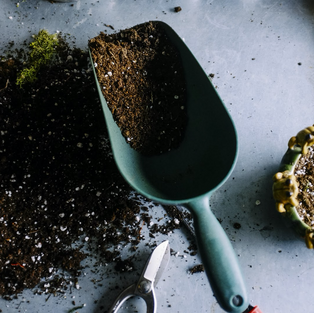How to Keep Supermarket Herbs Alive: 5 Top Tips
- Dish

- May 28, 2020
- 6 min read
Updated: May 16, 2021
1. Choose the right plants
2. Repot them with fresh potting mix and larger pots
3. Split up overcrowded plants
4. Water regularly
5. Harvest them correctly

Have you ever struggled to keep your herb pots alive?
Most of us have bought potted herbs from supermarkets at some point in our lives. There are few things that step up your cooking game as much as having fresh herbs to hand and there’s definitely an appeal to harvesting food you’ve grown yourself!
However, supermarket herbs often meet a common fate of not surviving very long at all. We then end up resorting to buying pre-cut herbs, which can be quite expensive (especially when making heaps of Mojitos) and are almost always packaged in single-use plastic.
In today’s blog we’re going to explain five key steps to help you get the most out of your supermarket pot plants, so they survive longer and produce more in the long run. If grown correctly, some perennial herbs like Mint, Rosemary and Thyme can live for many years!
1. Pick the Right Plants
The first thing to consider is being selective when you choose your plants. Most large supermarkets (and garden centres) stock a fairly good variety of potted herb plants, with the most common being Basil, Mint, Parsley, Coriander, and sometimes Thyme, Rosemary, Oregano and Sage.
The key when buying potted herb plants is to pick the healthiest ones, they will grow faster and produce more for you in the long run. They’re often sold in a plastic sleeve: I’d recommend briefly sliding the plant out of the sleeve to get a better view of it and inspect for any damage. Here are some key things to look out for:
Avoid buying plants with discoloured or wilted leaves
Avoid buying plants with broken or damaged stems.
Avoid buying overgrown plants with tangled stems, most common with Parsley, Coriander, Oregano and Thyme.
2. Repot Them!
If you’d like to keep your potted plants growing for longer it’s essential they are re-potted with fresh potting mix. Once you have brought your plants home, you should get your growing medium ready. The mix should be rich in organic matter and free-draining.
The easiest potting mix to make is a combination of multi-purpose compost and perlite. The compost has all of the organic matter and nutrients needed as well as moisture retentive properties. Perlite is a volcanic rock, which creates pore spaces within the soil, increasing drainage whilst aerating your growing medium. To make your potting mix go further, you could add coco coir or peat moss to bulk it up.
To re-pot, you will of course need a few plant pots. One of the most common reasons supermarket herb pots don’t last long is because they’re root bound. This means the roots have overgrown the pot they’re in and have begun to grow in circles trying to find more space, water and nutrients.
A bigger pot will allow the roots to spread out and grow into a larger, healthier plant. Ideally the pots or containers should be about twice the size of the supermarket pots. If you don’t have any old pots lying around, you can also use any other large plastic containers like ice cream or yoghurt tubs, as long as you make some drainage holes at the bottom.
In preparation, add an inch or two of growing medium to the bottom of the pots so they are ready for the next step.
3. Split up Overcrowded Plants
Most herb plants you will buy are multi-sown, this means multiple seeds are sown in the small nursery pot, which leads to overcrowding as they grow. Unless your pot of herbs has only one or two stems, like some supermarket Basil plants, I would advise that you split it and make two separate plants.
Carefully squeeze the pot to release the plant. Try not to pull on the stems to do this but instead try holding the plant pot sideways and it usually pops right off.
Carefully holding the plant upright, use both of your thumbs to separate the root mass into two. It helps to try and find a place where the roots and soil easily separate into two masses. The key here is to minimise the damage to the roots. If you feel confident that the root masses are large enough with lots of intact roots, you can split it again to have four separate plants.
Place the desired section into one of your pots and begin to add potting mix until the plant is completely supported. I find using a large tablespoon allows me to carefully add mix into hard to reach spots in the pots.
4. Water your Herbs Regularly
Next, water your plants thoroughly and make sure not to allow them to dry out between waterings. If you have used a nutritious compost mix, you may not want to fertilise your plants with additional nutrients. Herbs are not heavy feeders but if you’d like to use liquid fertilisers you can do this once a month during spring and summer.
5. Harvest your Herbs Correctly
At this point you’ve split and repotted your herbs into multiple pots with lots of fresh growing medium. The truth is that all your efforts could be lost if you harvest your plants in the wrong way. If you use the right method and avoid harvesting too much too often, your plant will thrive. Remember, your pot plant will have multiple individual plants, which each need to be harvested using the same method.
Below is a quick guide on how to harvest common herbs.

Basil - Harvest only the tips of the basil plants every two weeks or so. Remove the tips from above a node without damaging the small leaves on the node. The nodes on a plant are where the leaves grow from along the stem. These small leaves will produce sideways (lateral) growth, which you can harvest later. The key is to be patient, you’ll be able to harvest far more when the plants are more mature and bushier!
Mint - Harvest the tips of the plants every two weeks or so. Mature plants can be harvested more often. Remove the tips from above a node. This will then grow laterally and you can repeat. In the long run this will make the plant grow fuller and bushier.
Coriander - Remove 1 or 2 of the outermost stems from each plant and allow the middle to grow for an additional week or two before picking again. Coriander has a tendency to bolt (go to seed) quickly so make sure you harvest routinely to get the most out of your plants.
Parsley & Dill - You can harvest in the same way as Coriander, but I prefer to harvest all of the mature stems on a plant, making sure to leave the small new growth. You will recognise these stems as being short and with compact frilly leaves. These will grow new large stems in 2 weeks which can be harvested in this way 3 to 4 more times.
That's it!
So there it is! We’ve given you some top tips, not only to keep your supermarket herbs alive, but to help them thrive! Remember to choose healthy plants, repot them into fresh potting mix in larger pots, split up overcrowded plants, water them regularly and harvest appropriately.
Try these tips and you will see more of these herbs finding their way to your plate! The versatility and robustness of herb plants allows us to grow the flavours from across the world in our temperate British gardens and that is something we should all be taking advantage of!
I hope you find this blog useful, if you're looking for more tips or fun ways to grow at home, check out my latest blogs on growing plants in a water bottle, growing from food scraps, or how to grow microgreens. Happy growing!
Dish is Square Mile Farms’ Head Grower. He’s on a mission to reconnect people with their food by helping them grow it themselves! Square Mile Farms bring vertical, urban farming to city dwellers in their homes and in the workplace. We aim to bring people closer to food production and help to create a culture of healthy, sustainable living.
Find out more about our offering and get in touch here with any queries. Sign up to our newsletter for tips on a healthy lifestyle and a round-up of relevant news and join our online Urban Growing Community for advice on growing at home and much more!
.jpg)





















Thank You so much for such a simple yet informative guideline! Can you please share the pics of coriander, how to cut it?